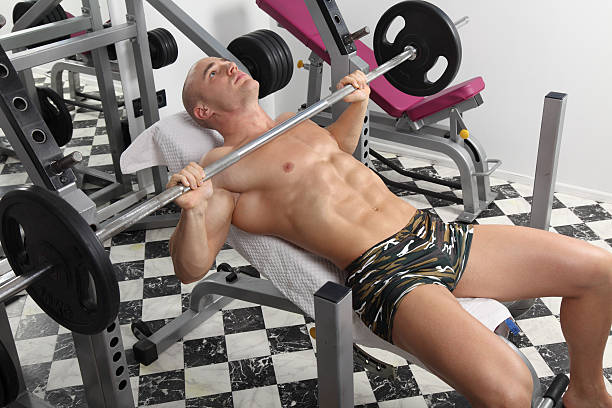Barbell Curls Lying Against An Incline Bench
The lying incline bench barbell curl is one of the best bicep exercise in terms of pure isolation and negating momentum.
Both standing and seated barbell and dumbbell exercises are susceptible to momentum, swinging and poor form – utilizing a lying barbell curl eliminates the ability to lean back and swing.
Movement: Isolation
Targets: Biceps
Required: Barbell & Incline Bench
Optional: N/A
Barbell Curls Lying Against An Incline Bench Form:
Lay stomach down on an incline bench adjusted to roughly a 45 degree angle, hold a barbell at arms length down in front of you.
Maintain the position of your upper arms while you proceed to curl the weight up, contracting the biceps.
At the top of the movement pause and squeeze this contraction for 1 second.
Slowly lower the barbell back down until your arms are extended once again.
Repeat for the desired number of repetitions.
Barbell Curls Lying Against An Incline Bench Variations
Lying Dumbbell Curls
Performing the same form and movement however grasp a dumbbell in each hand with a neutral grip and rotate your pinky finger towards your shoulder at the top of each curling repetition to contract the biceps.
Incline Hammer Curl
A hammer curl while performed laying down on a incline bench adjusted to a 45 degree angle.
The dead hang of the arms ensures no momentum or swinging comes into play while performing your hammer curls – providing superior isolation
Here’s The Barbell I Use & Recommend…
I’ve been using one of these ‘The Beast” 7 foot olympic barbells in my home garage gym for the last 6 years, it’s affordable, high quality and gets the job done regardless of how many 45lb plates are loaded on it.
Check it out and invest in a high quality “The Beast” barbell.
Common Barbell Curls Lying Against An Incline Bench Mistakes
Swinging
Every guy in the gym wants to swing around heavy weight on biceps, I get that.
As I said earlier – if you want to build big arms you’re going to have to lift heavy, HOWEVER form always have and always will take priority over the weight being lifted.
The bottom portion of a bicep curl is without a doubt the hardest portion of the movement, and when lifting too heavy many gym-goers attempt to swing backwards or hip thrust to attempt to move the weight.
Using momentum to move the weight takes tension off the bicep, doing you no good.
If you’re swinging and swaying your back on every repetition you’re also placing your lower back at a high risk of injury – not good.
Pick a weight that’s heavy for you to perform with good form, save the cheat curls for Arnold.
Not Contracting The Biceps Correctly
The whole point of the biceps curl is to contract and overload the muscle – if you’re performing the repetitions too fast and not taking the time to squeeze at the top you’re not going to see much in terms of strength or size gains in your biceps! Take the time to hold for the count of 1 second at the top of each repetition before lowering the weight back down to a dead hang.
Arm Training Frequency Too High
it didn’t take me long to realize that training my arms every single day wasn’t getting me very far in terms of results given all the effort I was exerting.
Train smart.
The biceps act as the secondary muscle group when we’re training back, and the triceps act as the secondary muscle group when we’re training chest.
Training chest, back and one dedicated arm day per week (or triceps and biceps split up onto seperate days instead) is more than enough to build big, strong arms.
More isn’t always better – if you’re training frequency is any higher than this you may very well be hindering your own progress, like all other muscle groups the biceps and triceps require time to recover.
Lifting Too Light
If you don’t generally train in the lower rep range I recommend you give it a try, stop lifting in the 10 – 15 rep range for at least a month and focus on heavy, low rep sets. Once you start to see results you won’t want to go back.
Now, you may still think high reps are beneficial, but let me tell you they’re far from it.
High repetitions result in increased stress on your CNS, increase in localized inflammation and increased soreness.
“Movements or exercises that do not give the muscle the required resistance, but are the kind that involve a great number of repetitions, never break down any tissue, to speak of. These movements involve a forcing process that cause the blood to swell up the muscle, and simply pump them up”– George F. Jowett, 1926
Similar & Substitute Exercises
- Barbell Bicep Curl
- Incline Dumbbell Curl
- Dumbbell Preacher Curl
- Seated Dumbbell Incline Curl
